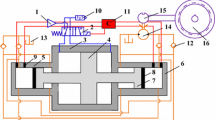Abstract
Based on the vehicle simulation software ADVISOR, the model of a parallel air-fuel hybrid vehicle was established, and the modeling of an air powered engine (APE), heat exchanger, braking air tank and control strategy were discussed in detail. Using the vehicle model, a hybrid vehicle refitted from a traditional diesel car was analyzed. The results show that for the New European Driving Cycle (NEDC), the Urban Dynamometer Driving Schedule (UDDS) and the Highway Fuel Economy Test (HWFET) driving cycle, the total reductions in fossil fuel consumption of the hybrid vehicle were 48.29%, 48.51% and 22.07%, respectively, and the emissions could be decreased greatly compared with the traditional diesel car, while the compressed air consumptions of the hybrid vehicle were 97.366, 85.292 and 56.358 kg/100 km, respectively. Using the diesel equivalent as the indicator of fuel economy, the hybrid vehicle could improve the fuel economy by 14.71% and 16.75% for the NEDC and the UDDS driving cycles and decrease by 5.04% for the HWFET driving cycle compared with the traditional car. The simulation model and analysis in this paper could act as the theoretical basis and research platform in optimizing the key components and control strategy of hybrid air-fuel vehicles.
Similar content being viewed by others
References
Chen Ying, Liu Hao, Tao Guoliang. Simulation on the port timing of an air-powered engine. International Journal of Vehicle Design, 2005, 38(2): 259–273
Liu Lin, Yu Xiaoli. Practicality study on air-powered vehicle. Frontiers of Energy and Power Engineering in China, 2008, 2(1): 14–19
Pinglu CHEN, Xiaoli YU, Liu Lin. Simulation and experimental study of electro-pneumatic valve used in air-powered engine. Journal of Zhejiang University Science A, 2009, 10(3): 377–383
Knowlen C, Mattick A T, Bruckner A P, Hertzberg A. High efficiency energy conversion systems for liquid nitrogen automobiles. SAE Transactions, 1998, 981898
Liu H, Tao G L, Chen Y. Energy analysis on power system of airpowered vehicle. Journal of Zhejiang University (Engineering Science), 2006, 40(4): 694–698 (in Chinese)
Schechter M M. Regenerative compression braking-a low cost alternative to electric hybrids. SAE Transactions, 2000, 2000-01-1025
Higelin P, Vsile I, Charlet A, Chamaillard Y. Parametric optimization of a new hybrid pneumatic-combustion engine concept. International Journal of Engine Research, 2004, 5(2): 205–217
Andersson M, Johansson B, Hultqvist A. An Air hybrid for high power absorption and discharge. SAE Transactions, 2005, 2005-01-2137
Tai C, Tsao T, Levin M B, Barta G, Schechter M M. Using camless valvetrain for air hybrid optimization. SAE Transactions, 2003, 2003-01-0038
Huang K D, Tzeng S C. Development of a hybrid pneumatic-power vehicle. Applied Energy, 2005, 80(1): 47–59
Alexander D. Scuderi’s split-cycle solutions. Automotive Engineering International, 2006, 114(5): 24–26
Liao G Y, Weber T R, Pfaff D P. Modelling and analysis of powertrain hybridization on all-wheel-drive sport utility vehicles. Proceedings of the Institution of Mechanical Engineers, Part D: Journal of Automobile Engineering, 2004, 218(10): 1125–1134
Katrašnik T. Hybridization of powertrain and downsizing of IC engine: Away to reduce fuel consumption and pollutant emissions-Part 1. Energy Conversion and Management, 2007, 48(5): 1411–1423
Yu X L, Yuan G J, Shen Y M, Liu Zhentao, Su Shichuan. Theoretical analysis of air-powered engine work cycle. Chinese Journal of Mechanical Engineering, 2002, 38(9): 118–122 (in Chinese)
Kellaway M J. Hybrid buses-What their batteries really need to do. Journal of Power Sources, 2007, 168(1): 95–98
Markel T, Brooker A, Hendricks T. ADVISOR: a systems analysis tool for advanced vehicle modeling. Journal of Power Sources, 2002, 110(2): 255–266
Liu Hao, Tao Guoliang, Chen Ying. Research on the displacement and stroke-bore ratio of the air-powered engine. Journal of Engineering Design, 2006, 13(4): 381–384
Nie X H, Yu X L, Hu J Q, Chen P L. Influence of inlet and outlet valve’s open timing on pneumatic engine and their optimal design. Journal of Engineering Design, 2009, 16(1): 16–20 (in Chinese)
Author information
Authors and Affiliations
Corresponding author
Rights and permissions
About this article
Cite this article
Chen, P., Yu, X., Nie, X. et al. Modeling and simulation analysis on parallel hybrid air-fuel vehicle. Front. Energy Power Eng. China 4, 553–559 (2010). https://doi.org/10.1007/s11708-010-0008-y
Received:
Accepted:
Published:
Issue Date:
DOI: https://doi.org/10.1007/s11708-010-0008-y




